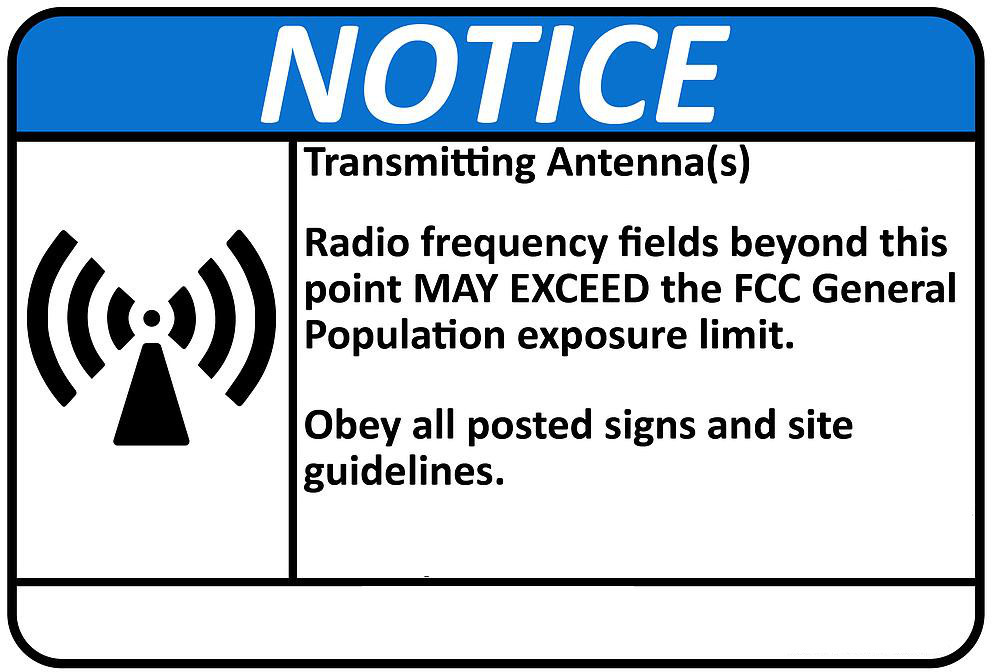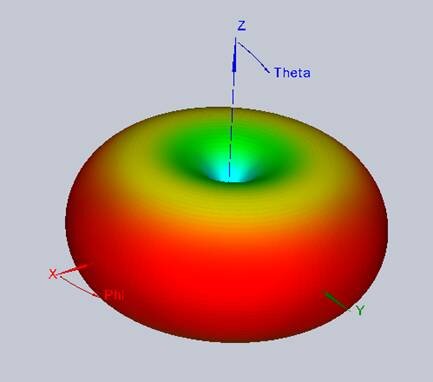
I’m getting ready to install a radio antenna on my home’s roof, and hoping to avoid hurting myself or anybody else in the process. While falling off the roof may be the most obvious risk, a less obvious concern is the radio frequency energy from the antenna when it’s transmitting. Is this something to worry about it? How much RF exposure is too much? Let’s take a look.
Electromagnetic waves in the radio frequency spectrum are what’s called non-ionizing radiation. They don’t have anywhere near enough energy to knock electrons loose from an atom or molecule. Unlike x-rays or gamma rays, they can’t cause radiation sickness, genetic damage, or cancer. The primary human risk from RF is heating up tissue – it can cause burns or literally cook you. This is how a microwave oven works, for example. There’s no risk for a human near an antenna that’s only receiving, but you need to be careful any time the antenna is transmitting. The risk depends on several factors, some obvious ones and some less obvious:
- Transmitter power – Higher power means higher RF energy levels.
- Distance from the antenna – The closer you are to the antenna, the higher your exposure.
- Transmitter duty cycle – Exposure is averaged over a period of several minutes. A 100 watt continuous transmission creates equivalent exposure to a 200 watt transmission alternating 1 minute on, 1 minute off.
- Height above ground – Radio waves can bounce off the ground and reflect back up, concentrating more of the total energy in a single spot.
- Proximity to buildings and nearby objects – Radio waves can also bounce off buildings, creating a similar effect to ground bounce.
- Antenna type – RF energy isn’t radiated equally in all directions. Some antenna types concentrate more energy at low elevation angles close to the horizon, or in specific directions. A human in the high-concentration zone will get higher RF exposure.
- Transmission frequency – The human body is most efficient at absorbing RF energy in the 30-300 MHz frequency range, so the risk is higher for radio transmissions in this range.
- Transmission mode: voice, digital, or Morse code – A 100W-rated radio that’s continuously transmitting may not be outputting 100W continuously; it depends on the transmitted signal. Continuous wave (CW or Morse Code) transmissions come closest to reaching the advertised power all the time. FM voice does too. But AM voice and single sideband (SSB, a type of AM) transmissions have an instantaneous output power that depends on how loudly you’re speaking at that moment. If you’re silent, the power is effectively zero.
In the United States, the FCC’s OET Bulletin 65 Supplement B describes the maximum permissible exposure or MPE limits for RF electromagnetic fields, and some methods used to calculate the exposure. MPE limits are defined in terms of power density (units of milliwatts per centimeter squared: mW/cm 2), electric field strength (units of volts per meter: V/m) and magnetic field strength (units of amperes per meter: A/m). Fortunately you don’t need to understand the details of all this, and can simply use their data tables to determine how far away people must be from the antenna in order to stay safe.
Controlled and Uncontrolled Exposure
The FCC sets two different MPE limits, for controlled and uncontrolled exposure. The controlled limits are higher, and they apply when people know they’re close to an antenna and have been trained to understand the potential risks. Typically this would mean a workplace setting, but controlled exposure limits also apply for licensed amateur radio operators and their families, assuming they’ve had RF safety training. The uncontrolled exposure limits apply to the general population, who may be completely unaware of the risks or who don’t know there’s an antenna present.
I don’t understand the reasoning behind this. Just because someone knows there’s an antenna, and has received RF safety training, how does that make their body less susceptible to injury from RF energy? If you can explain this, please do. For my home, I’m choosing to use the stricter uncontrolled general population exposure limits even though I’m not required to.
Doing the Math
Let’s look at some specific numbers. I’m installing a dual-band VHF/UHF antenna that’s a clone of the Diamond X30. It transmits at about 145 MHz for VHF, or about 450 MHz for UHF. It’s a vertical antenna with an omnidirectional radiation pattern in azimuth, but the pattern is squished vertically. More energy is radiated straight out toward the horizon, and less energy up or down where there’s usually nobody to talk to anyway. The radiation pattern is like a flattened donut, with the antenna centered at the hole in the middle.

This particular antenna has a gain of 3.0 dBi for VHF and 5.5 dBi for UHF. This gain isn’t true amplification, it’s just a measure of how concentrated the RF energy is in the direction of interest relative to a hypothetical reference antenna. The “gain” comes from the degree of squishing in that radiation donut.
The radio uses standard FM modulation, and has a maximum output power of 25 watts, although most of the time I’ll probably run it at lower power.
Marshalling all this information, we could use the data tables in the FCC bulletin to estimate the minimum safe distance from the antenna for uncontrolled exposure. Fortunately several people have created easy-to-use calculators based on the FCC data, so let’s use this RF exposure calculator from Paul Evans VP9KF. Plugging in 25 watts, 3 dB gain, 3 meter distance, 145 MHz, with ground reflection, the calculator tells us 3 meters is safe and 2.27 meters (7.45 feet) would be the minimum distance. With 5.5 dB gain at 450 MHz, the safe distance is 2.47 meters (8.1 feet).
Going the Distance
8.1 feet isn’t a huge distance, but neither is it small. I probably don’t want to put that antenna directly outside the window from where I’ll operate the radio, or on the roof directly overhead that spot. Nor should it be anywhere that somebody might come and sit within 8 feet of it for an extended period of time. This might not be easy to achieve.
It’s important to understand that this 8.1 feet number is the most pessimistic and conservative number. It assumes my radio is continuously transmitting 100 percent of the time, which it certainly won’t be. It assumes the 25W from the radio is completely radiated as RF energy, when in fact some energy will be lost in the transmission cable to the antenna. It assumes the worst possible ground bounce. And it assumes a person is in the main lobe of the antenna’s radiation pattern, where the energy is concentrated. For this particular antenna, if it’s on the roof and people are below it, their RF exposure will be less because the antenna radiates most energy horizontally rather than up and down.
My planned location for the antenna is on a mast, mounted above the second story roof, above my garage. Yes my garage is on the second story of my home. Ideally the mast would be as tall as possible, but to minimize the visual impact and possible neighbor complaints, I’ll be using a very short mast – about 1 foot. If someone were standing at the back of my garage for an extended period of time, they’d be about 5 feet below the antenna. This might be a small concern, although it still meets the MPE for controlled exposure even before considering all the mitigating factors just mentioned. Outside the garage, it’s impossible to get closer than about 13 feet to the antenna unless you’re standing on the roof. We should be fine.
from Hacker News https://ift.tt/oke2X85
No comments:
Post a Comment
Note: Only a member of this blog may post a comment.